
How to boost website traffic and organic growth with NLP
Have you also found that despite following all SEO strategies you’ve read about, your website traffic has not improved significantly?
It is because the SEO strategies covered in SEO books do not tell you the whole story.
Top SEO agencies apply Natural Language Processing (NLP)
Although Search Engine Optimization (SEO) is perhaps the least expensive digital marketing technique for creating organic growth, growing website traffic with SEO and digital marketing is not a simple matter. You have to understand strategic marketing, how search engines work, and the role of advanced analytics.
The good news is that MarketingStat has created an SEO process that applies advanced analytics and NLP to increase the odds that your webpage will climb the SEO rank, creating website traffic and driving organic growth.
Keep reading. I explain how to improve website traffic with modern SEO techniques built upon NLP and digital marketing that search engines understand correctly and rank accordingly.
Ask MarketingStat for help with your website traffic.
We are not the typical SEO agency. And you’ll like it!
What is NLP?
Natural language processing is a specialized field of artificial intelligence, with roots in computational linguistics, that empowers computers to process and understand human language.
MarketingStat’s SEO process applies the algorithm originally developed to help search engines rank search results. It is called TF-IDF and its strength lies in the ability to reduce overshadowing, which is the effect of hiding less frequent search terms behind terms occurring more frequently.
This concept is at the root of the relationships between Google’s search string words and it is the computational ground on which we map our clients’ SEO Space.
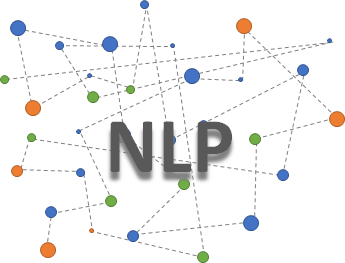
What is SEO?
Search engine optimization ensures that webpages speak the language search engines understand.
For instance, roughly 6 million times a year someone searches Google for “best dog food”. If I sell dog food, I want to be one of the top five Google rankings, because 7 out of 10 times search engine users click on one of the top 5 Google search results.
And 9 out of 10 people click on a link on the first search engine results page.
Search engine optimization is a great source of low-cost website traffic.
Successful digital marketing and organic growth cannot happen without search engine magic.
MarketingStat helps companies of all sizes make that magic happen. It could be yours.
SEO is not art. It is science.
MarketingStat has perfected an SEO process based on how Google and other search engines think.
We follow the search engine path to establish relationships between content topics and search text.
These relationships are visualized on a map we call the SEO Space.
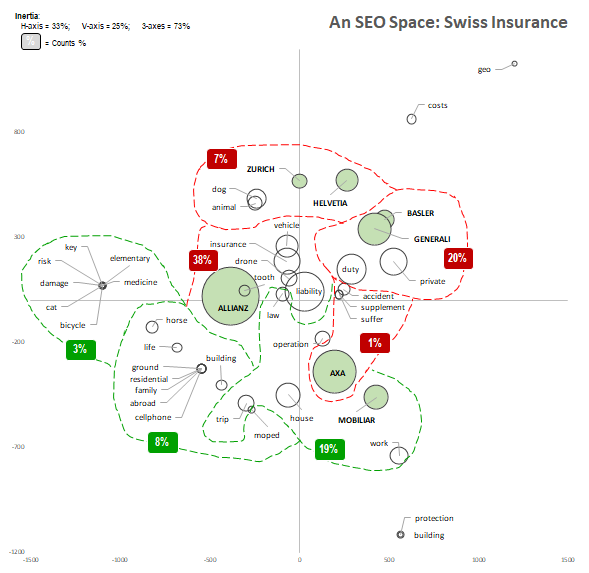
What is the SEO Space?
The SEO Space is the search ground on which comparable webpages compete to increase website traffic. It is the collection of related search strings you want search engines to associate your webpage with, and put at the top of their rank lists.
MarketingStat defines the SEO Space in such a way that everything is measurable and measured. Priorities can be easily set, and results are tracked on an ongoing basis.
The Semantic Network
The Semantic Network is a graphic representation of the search concepts associated with the seed concept. “pet” in the example.
For instance, say we sell pet ware. The Semantic Network might look as in this image
Treated appropriately, this information defines the business’s SEO Space.
Organic growth reflects how well a webpage covers its SEO Space, which in turn depends on the quality of the Semantic Network.
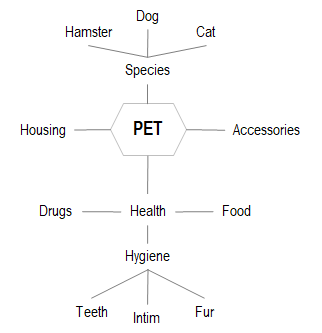
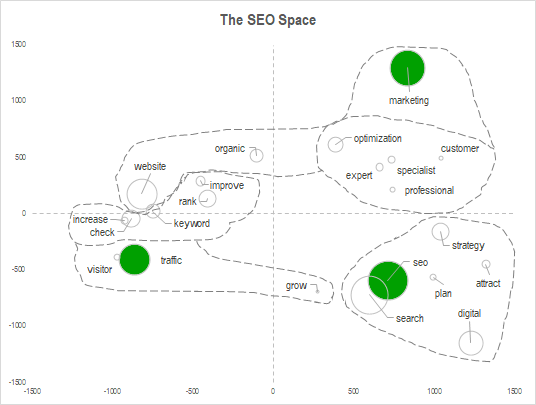
Mapping the SEO Space: Path to organic growth
The map on the left shows the SEO Space for a business consulting agency.
This map makes the SEO Space visible. It shows the search segments, their search volume, and the proximity between words.
This information is extremely useful for defining, selecting, and prioritizing the search segments to tackle with digital marketing and SEO strategies.
MarketingStat aligns all of this with the Marketing Strategy and the Copy and the Media strategies of your brand. If you have not formalized these strategies yet, we can help you do so.
A solid digital content strategy is the prerequisite to sparking organic growth with digital marketing.
What is word proximity?
The proximity of words is a key concept of the process search engines apply to understand and associate search terms. Proximities are determined by the frequency of association in search strings and by the semantic meaning of the words.
For instance, the following image shows how the word “survey” can take on at least two different meanings.

The word “survey” has unrelated meanings.
How do search engines know whether to show a list of one or the other group?
With proximal associations.
They consider each word as a distinct entity and create a bag of related terms. The challenge for the SEO expert is to reverse engineer the search engine ranking reasoning, uncover the hidden relationships between terms, and create SEO content that search engines understand.
The solution requires intelligence.
Modern search engines apply a method of artificial intelligence called TF-IDF. This is exactly the same approach MarketingStat uses to make sense of thousands of search strings related to your SEO Space.
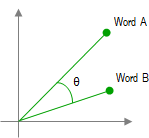
Do not search further.
Ask MarketingStat now how to turn your website into a traffic magnet.
SEO is a matter of language
Valuable SEO content is not only about what you write (keywords), how much you write (text content), and how you write it (text position and font).
Strong SEO content places heavy weight on how to say what you say.
The words you use and their proximity are key factors in SEO results.
The only problem is that it’s not easy to do, so most SEO consultants prefer to ignore the proximity concept.
Not MarketingStat.
Optimizing a web page without accounting for word proximity is like saying “I live in the red house”.
Without providing a city and street address it will be hard to find you.
MarketingStat can teach your webpages
how to tell search engines exactly where to find them.
Search engines think by proximity
No matter how good your digital marketing strategy is, strong organic growth cannot be attained with SEO strategies based on intuition and common sense.
Search engines do not think that way.
Search engines measure the (dis)similarity between words, rank it, and determine the proximal relationship between search terms. This is how search engines make sense of search strings.
If you do not mention the right, proximal words, your site is not ranked high; but if you do, organic growth improves.
So, which are the right words to mention?
When we show our clients their SEO Space and explain the role of information proximity, it is easy to understand which terms to use and why the old SEO strategy cannot work: The connections between concepts are missing, so search engines do not understand how to classify your page, which results in a bad SERP ranking.
MarketingStat solves the issue by drawing, on a positioning map, the search field where your webpages compete. This way, it is easier to create a powerful digital strategy. For complex and multifaceted businesses too.

Keywords have profiles
Word profiles embed connections. Connections underlie proximities, and proximities influence SEO success.
MarketingStat knows how to find, measure, and prioritize the proximities that spark organic growth and bring traffic to your web pages.
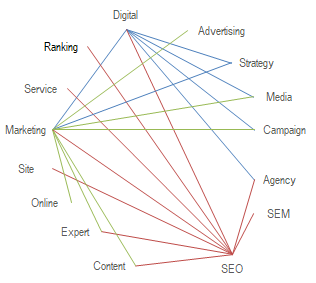
What is a search string?
A search string is the synthesis of a mental process concerning a topic of interest, at a given time.
Interconnected strings let patterns emerge concerning how people think and act, and what bothers them.
For instance, why do some people do a search for “market research” while others search for “survey”?
Is it just by chance or are there particular reasons behind this word usage?
Answering questions like these enables us to prioritize the content of a webpage with a strategic purpose in mind. This makes setting a challenging objective and creating a compelling digital strategy for your online presence easier.
By the way, the analysis of the Semantic Network of the term “market research” shows that it associates strongly with “planning” concepts, like “strategic planning”, “business plan”, and the like; while “survey” associates more strongly with concepts closer to the statistics field, with strings like “sampling plan”, “results analysis”, “questionnaire”, and the like. Depending on the people we want to speak to, we may favor one concept over the other, for instance, analysts with “survey” and marketers with “market research”.
Mapping the word relationships makes the SEO Space visible and measurable. This is a feature that business decision-makers appreciate a lot because it makes setting goals and choosing strategies easier, and it is a valid aid to strategic planning.
MarketingStat accompanies clients to increased website traffic
applying low-cost, digital marketing techniques spiced with deep learning and NLP.
It is new. It is AI powered SEO!
Closing the SEO process loop
At this point, the process to determine how to create webpages that increase website traffic is complete.
It is time to work on content optimization, publish it online, wait for search engines to index the page, and monitor the outcome of your content strategy.
The cycle to stimulating organic growth of your website traffic is set and running.
Later on, we will verify the relevance of your SEO Space.
If you, like hundreds of other companies, ask MarketingStat to look after your website optimization, we will monitor your SEO relevance over time. If we find that your SERP ranking has declined, we will advise you to review the website content.